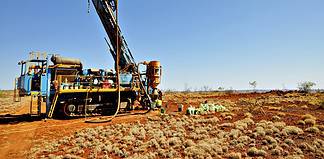Image: Renascor Resources.
BY ELIZABETH FABRI
LITHIUM has been the poster child for the booming battery metals market. However, what many may not know is the anodes in lithium-ion batteries contain far more graphite than they do lithium, with analysts of the view it’s just a matter of time before demand takes off.
Graphite demand and prices are about to skyrocket.
According to Roskill, the market will soon see a rapid period of growth driven by – you guessed it – the rising lithium-ion battery industry.
Graphite itself can come in two forms; natural graphite which is mined and processed, and synthetic graphite which is made from petroleum coke.
Then there’s graphene; an allotrope form of carbon comprising one atomic layer of graphite arranged in a hexagonal lattice, which is the strongest material recorded.
In its 2018 Global Industry, Markets & Outlook 2018 report, Roskill forecasts consumption of graphite in battery applications to be five to 10 times higher by 2027 than the current level, pending the uptake of lithium-ion battery electric vehicles.
“Roskill forecasts electric and hybrid vehicles could account for 69 per cent of all motor vehicle sales by 2027,” Roskill stated.
“With battery demand from these electric vehicles as well as an unprecedented surge in stationary storage, the future for battery graphite is exciting.”
Australia is fortunate to have a large number of graphite focussed ASX-listed companies with projects at various stages of development, particularly overseas in Europe, Mozambique and Tanzania.
Industrial minerals consultant Andrew Scogings said Tanzania, Mozambique and other nearby countries such as Malawi and Madagascar had numerous graphite deposits that were characterised by a wide range of flake sizes that could supply a variety of markets.
“In fact, the term ‘Jumbo Flake’ was coined for an East African deposit, given that several of the East African deposits often have a higher proportion of large flakes than other locations,” Dr Scogings said.
“It is believed that Chinese deposits (China is the global leader in flake graphite production) don’t have as many of the large flakes, which are in demand for expandable graphite used in fire retardants and in making graphite foils for electrical and computer applications.”
On the other side of the size distribution, Dr Scogings said small flakes less than 150 micron were in demand for spheroidal graphite.
“It is reported that some East African explorers/producers can achieve higher purity (e.g. >96 per cent carbon) for small flakes (minus 150 micron) which is higher than the current 94 per cent purity graphite being used to make spherical graphite in China,” he said.
“The use of higher purity feedstock to make spherical graphite reduces the cost of chemical and or heat treatment to raise the purity to above 99.9 per cent, which is needed for batteries.”
ASX companies currently making moves overseas included Talga Resources which had established a vertically integrated business that starts with its large European graphite deposits; and Syrah Resources, which was now the largest global producer of natural flake graphite after commencing mining at its Balama project in Mozambique in 2018.
Closer to home there was also an emerging group of Australian-focussed explorers hitting ground.
Renascor Resources was a leader of the pack, along with peers Lincoln Minerals, Hexagon Resources and Mineral Resources, with plans to begin construction on its Siviour graphite project in 2019 and production in 2020.
Renascor’s South Australian deposit was considered the largest graphite deposit in Australia, and the fifth largest graphite deposit in the world.
“But it’s more than just large,” Renascor managing director David Christensen said.
“We’ve been able to produce a high-grade, high-quality graphite product from Siviour, and our recently completed PFS suggests Siviour can be among the lowest cost producers in the world.
“Our goal is to give Australia a world class graphite mine that can compete in any price environment with any development in the world.”
Mr Christensen said the price of flake graphite (the kind most mines like Siviour would produce) was currently hovering between $US800 per tonne and $US1800/t depending on the size and purity.
“The prices have been gradually rising over the last six-months and are projected to continue this trend, subject to potential disruption,” he said.
“On the demand side, the biggest potential disruption is probably the use of flake graphite in lithium ion batteries.
“Graphite for lithium ion batteries currently accounts for around one-fifth of flake graphite demand, but is projected to account for significantly more in the very near future.”
ASX-listed Syrah Resources’ Balama graphite mine in Mozambique was opened in 2018. Image: Syrah Resources.
Challenges
While market fundamentals looked strong, a common hurdle experienced among emerging producers was locking in finance.
“Graphite is easy to find and relatively easy to mine,” Mr Christensen said.
“The hard part is producing a product at a low enough cost to be able to finance the mine’s development and stay in business.
Mr Christensen said a point of difference of its Siviour project was its location in a modern, established part of Australia.
“We can start our development without having to pay large sums of capital for infrastructure,” he said.
“I may be biased, but it’s hard to think why any other place would be better than Australia – provided you can find a high-quality deposit.
“We think we’ve really ticked this box with Siviour, as the project economics and quality of the graphite product stacks up with any development in the world, including those in Tanzania and Mozambique.”
Dr Scogings said investors were also still treading with caution as they hadn’t seen the dramatic price increases in graphite as for lithium.
“However, the word in the market is that graphite prices are rising, that the Chinese are importing graphite and apparently are prepared to pay more for higher purity products especially in the batteries market,” Dr Scogings said.
“The graphite market is also relatively diverse with a wide range of specifications (e.g. flake size distribution and purity) in addition to moisture, bulk density, trace element impurities and also performance requirements such as expandability and oxidation temperature.”
Dr Scogings said another key requirement of miners was to produce consistent quality graphite over extended periods of time.
“Industrial customers such as refractories manufacturers and spheroidal graphite processors need to have consistent sizing, purity and moisture contents for example,” he said.
“Producing consistent graphite quality is difficult if the deposit (the orebody) hasn’t been explored/defined in sufficient detail to enable selective mining if required, blending and consistent feed to the flotation plant to enable consistent product stream.”
Mr Christensen agreed, citing consistency as a challenge that often “gets overlooked” by industry.
“High-quality and low cost are essential, but the project must demonstrate the ability to be consistently high-quality and low cost,” Mr Christensen said.
“We think this is where we have another real advantage with Siviour.
“We have one massive deposit (rather than a series of deposits), so we will always be offering from the same source and delivering the same high-quality.
“To date, we’ve tested our material at labs all over the world (Australia, North America, Europe and China), and we’ve consistently demonstrated the ability to deliver.”
Dr Scogings said other important factors were determining what products can consistently be extracted from the ore, and whether the proposed products perform in targeted markets and offer competitive advantage.
“Further important factors are location, logistics and sovereign risk with cost of logistics often a game changer,” Dr Scogings said.
“A well-known saying for industrial minerals such as graphite is that ‘without a market, an industrial minerals deposit is merely a geological curiosity’.”









































